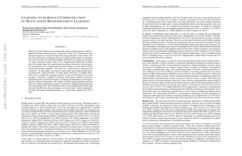Faceted Hierarchy: A New Graph Type to Organize Scientific Concepts and a Construction Method
On a scientific concept hierarchy, a parent concept may have a few attributes, each of which has multiple values being a group of child concepts. We call these attributes facets: classification has a few facets such as application (e.g., face recognition), model (e.g., svm, knn), and metric (e.g., precision). In this work, we aim at building faceted concept hierarchies from scientific literature. Hierarchy construction methods heavily rely on hypernym detection, however, the faceted relations are parent-to-child links but the hypernym relation is a multi-hop, i.e., ancestor-to-descendent link with a specific facet {``}type-of{''}. We use information extraction techniques to find synonyms, sibling concepts, and ancestor-descendent relations from a data science corpus. And we propose a hierarchy growth algorithm to infer the parent-child links from the three types of relationships. It resolves conflicts by maintaining the acyclic structure of a hierarchy.
PDF Abstract
